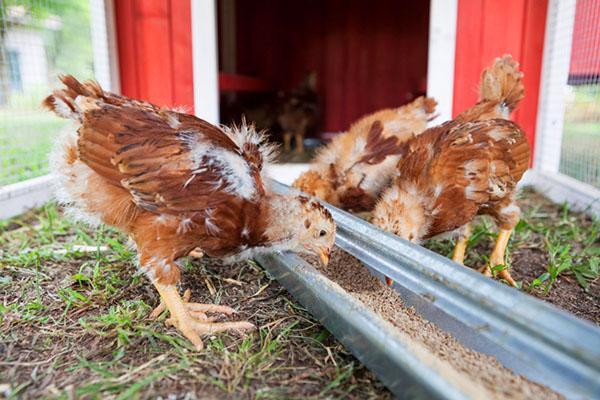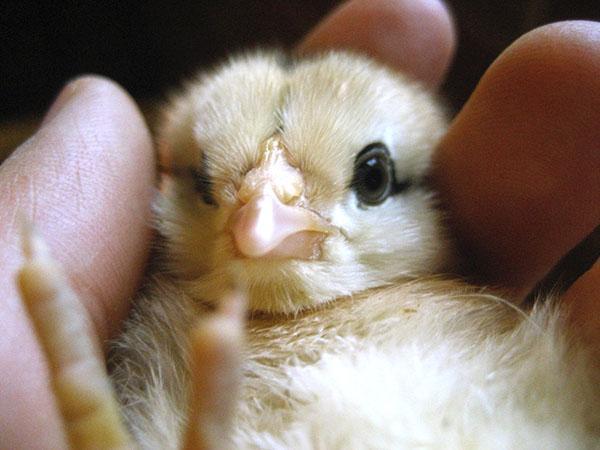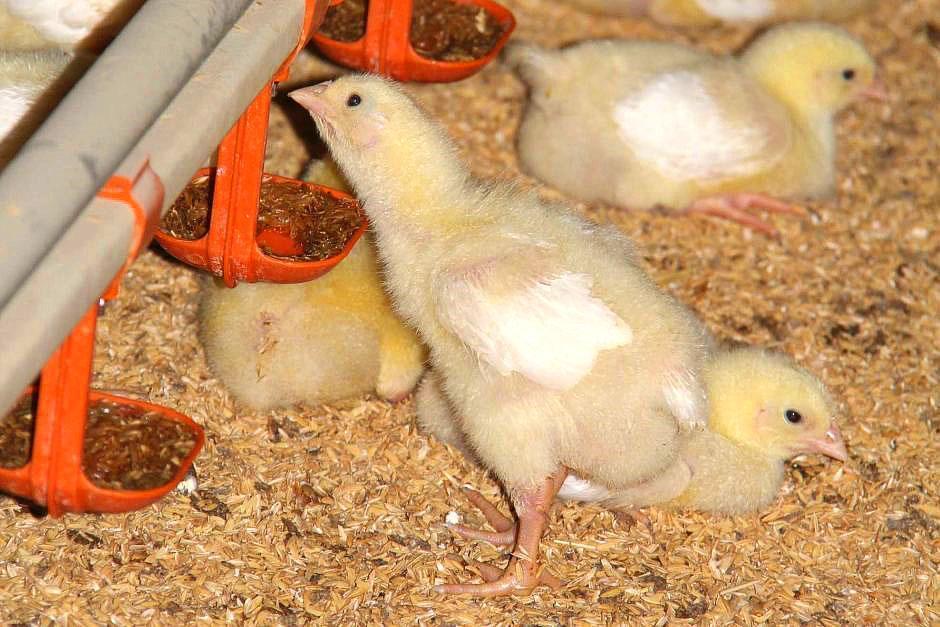Raising chickens, keeping and feeding at home
 An increasing number of backyard owners are convinced that keeping chickens for eggs or meat is profitable and not as troublesome as it seems. The most responsible and painstaking stage in this case is the raising of chickens, which require both a particularly careful attitude and a special feeding regime.
An increasing number of backyard owners are convinced that keeping chickens for eggs or meat is profitable and not as troublesome as it seems. The most responsible and painstaking stage in this case is the raising of chickens, which require both a particularly careful attitude and a special feeding regime.
How to choose feed and create conditions for young growth? How to care for chickens? And what are the preferred methods of keeping at home?
Caring for chickens in the first days of life

The first days of life are the most difficult and crucial period for both chicks and poultry farmers.
The care of day-old chicks, most vulnerable to disease and often suffering from poorly selected diets, should focus on creating and maintaining:
- required temperature regime;
- optimal air humidity;
- lighting and ventilation modes;
- balanced diet and nutritional dosage.
Dried strong chicks from the incubator are transferred to a brooder with conditions created for a comfortable habitat of the chicks or placed under an experienced hen.
 The basic requirements for the premises where the chick population is located are:
The basic requirements for the premises where the chick population is located are:
- dryness and cleanliness;
- maintaining proper temperature and humidity;
- correctly selected lighting and ventilation mode.
Before the poultry house accepts the chickens, it is cleaned, disinfected, dry, loose bedding is placed, the presence of protection from rodents is checked, and everything is completed with everything necessary to support the life of the pets.
This equipment includes not only lamps and heating devices, hygrometers and thermometers, but also feeders and drinkers. Their design should be chosen so that it is safe to use them, and the number is determined based on the number of livestock. No more than 12 chickens are settled per square meter when keeping chickens at home.
Subsequently, the premises are regularly washed, the old bedding removed, disinfected and ventilated.
Air temperature and lighting for growing chickens
 The first days and weeks of life, chicks often suffer from hypothermia or, conversely, excessively high temperature. The fact is that until the age of one month, the body of chickens cannot yet quickly and effectively adapt to changes in external conditions.
The first days and weeks of life, chicks often suffer from hypothermia or, conversely, excessively high temperature. The fact is that until the age of one month, the body of chickens cannot yet quickly and effectively adapt to changes in external conditions.
Therefore, the care of chickens in the first days of life must include strict control over the temperature in the house or brooder:
- The chicks should spend the first day in an atmosphere similar to that in the incubator. And for this, the air is warmed up to a comfortable 35 ° C.
- The next day, the room is gradually cooled. In the first week, the air can be 30–32 ° C.
- Such heating is necessary not only in the daytime, but also at night, the poultry farmer should be especially attentive in cloudy weather and periods of cold snaps.
- From the second week, the temperature is reduced by another couple of degrees, and the grown bird already feels great at a temperature of at least 21 ° C.
It is convenient to measure temperature using a thermometer located inside the house. It is better if the appliance is fixed slightly above the floor, at the level of the chicken. This will give the poultry farmer an accurate picture of the bird's health.
Whether the chickens are comfortable when keeping them at home can be judged by their behavior:
- Chicks crowded under the lamp or next to each other are clearly freezing.
- From the heat, the birds ruffle their feathers and wings, become inactive and sink to the floor.
 As much as temperature, proper lighting in the house is important when raising chicks. The first few days the lamps are not turned off at all. With this, the poultry farmer pushes the pets to eat, move and grow more actively. Then the chicks begin to gradually accustom themselves to the dark, turning off the lighting first for 15 minutes, then for half an hour, increasing the time for rest every day.
As much as temperature, proper lighting in the house is important when raising chicks. The first few days the lamps are not turned off at all. With this, the poultry farmer pushes the pets to eat, move and grow more actively. Then the chicks begin to gradually accustom themselves to the dark, turning off the lighting first for 15 minutes, then for half an hour, increasing the time for rest every day.
Feeding chickens at home
 A balanced diet, matched to age and needs, is a guarantee of good health and active growth of chickens. The first feeding of chicks when nursing and rearing at home is done shortly after the chicks are born. The earlier the young are offered food, the faster they acclimate.
A balanced diet, matched to age and needs, is a guarantee of good health and active growth of chickens. The first feeding of chicks when nursing and rearing at home is done shortly after the chicks are born. The earlier the young are offered food, the faster they acclimate.
Chicks usually become self-sufficient at around 8 hours of age. By this time, they can be offered a chopped, hard-boiled chicken egg. It is included in the menu for 3-4 days, gradually adding new healthy products to the diet.
The first addition is boiled millet, then chopped wheat and crushed corn appear on the menu. The choice of these two cereals is due to their good digestibility, which is not the case with oats or barley. The coarse shells of their seeds irritate the digestive tract and lead to diarrhea in chicks.
 Raising chickens at home assumes that not only dry food, such as cereals, but also greens, lactic acid products, mineral supplements, and potatoes should be used when feeding. Greens, which have a beneficial effect on digestion, enter the feeders already in the first days. This could be:
Raising chickens at home assumes that not only dry food, such as cereals, but also greens, lactic acid products, mineral supplements, and potatoes should be used when feeding. Greens, which have a beneficial effect on digestion, enter the feeders already in the first days. This could be:
- clover;
- scalded and chopped nettle;
- green onionscontaining, in addition to vitamins, mineral salts, moisture and fiber, phytoncides useful for poultry;
- root vegetables of carrots, which are given to chickens in a chopped form.
An irreplaceable source of protein at an early age is cottage cheese, whey, yogurt, buttermilk. They are added to wet feed and grain mixtures.
 From the fourth day, containers with fine gravel, shells and chalk are placed in places where chickens are kept at home, meat and bone or fish meal, which is an excellent source of animal protein, is added to the feed.
From the fourth day, containers with fine gravel, shells and chalk are placed in places where chickens are kept at home, meat and bone or fish meal, which is an excellent source of animal protein, is added to the feed.
When raised at home, chickens can be offered finely chopped meat trimmings or ground earthworms instead of flour. Protein intake is especially important when it comes to raising meat chicken breeds.
When caring for day old chicks, feeding is carried out at intervals of two hours, laying out the feed on flat sheets or pallets. Then the number of meals is reduced to 6, and after 2-3 weeks to four. The grown bird feeds in the morning and evening.
How to raise chickens at home if they were born in the cold season, when there is not enough green food? In this case, the bird is offered sprouted cereal seeds, which include a large amount of vegetable protein, fiber and vitamins. Herbal flour will also be a good help.
Excellent results when growing chickens are shown by feeding them with ready-made mixtures. Most often, such compound feeds are divided into starting, growth and finishing and differ in the size of the fraction and composition.
In addition to feed and mineral supplements, the house should always have clean water at room temperature.Also, chicks are regularly given a solution of potassium permanganate, which is a kind of prevention of intestinal diseases. The liquid is changed daily, along the way, thoroughly rinsing the containers. Drinking bowls for chicks must be safe. Since hypothermia is fraught with the death of the chick, it is impossible to allow the bird to get wet when drinking or can go into the water.
Features of keeping chickens at home
 During the period of raising chickens at home, special attention is paid to birds that are lagging behind in development, gaining little weight and eating less actively than their peers. To avoid further harassment from strong rivals, these chicks are caged and personally cared for.
During the period of raising chickens at home, special attention is paid to birds that are lagging behind in development, gaining little weight and eating less actively than their peers. To avoid further harassment from strong rivals, these chicks are caged and personally cared for.
From one week of age, when keeping chickens at home, they are satisfied with walking. Sun exposure is an important part of preventing rickets and other diseases caused by vitamin deficiencies and metabolic disorders.
The first walks last no more than an hour and a half, but growing chicks over time can stay in the pen for a walk longer and longer. The main thing is that the walking space is safe, well ventilated and well lit. For poultry, it is better to provide a canopy and drinkers and feeders placed under it.
Proper nutrition and maintenance of chickens - video
Part 1
Part 2
where to buy a nipple for a drinker
You can buy a nipple for a drinker at your veterinary pharmacy where you sell drinkers.
Help with the name of the flower
Day-old chicks are very difficult to raise with a high probability of death. But you can still try for the sake of experience.
Interesting. A very informative article. Very much passed to me.